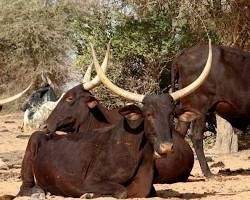 |
Bororo cattle, also known as Gudali or Guraphe, are a distinct breed of cattle primarily found in West Africa, particularly in countries like Nigeria, Cameroon, Chad, and Niger. Renowned for their adaptability to harsh environmental conditions and their vital role in the livelihoods of local communities, Guraphe cattle exhibit unique characteristics that make them invaluable assets in various agricultural settings.
Guraphe cattle are typically medium to large in size, with bulls weighing between 400 to 600 kilograms (880 to 1320 pounds) and cows ranging from 300 to 450 kilograms (660 to 990 pounds). They possess a robust frame, characterized by strong bones and well-developed musculature, which contributes to their resilience in challenging environments.
These cattle are known for their distinctive long, lyre-shaped horns that curve upwards and outwards, often spanning a considerable width. The horns serve multiple purposes, including defense against predators, regulating body temperature, and establishing social dominance within the herd.
Their coat coloration varies, commonly exhibiting shades of red, brown, or black, with some individuals displaying white markings on the face, belly, and extremities. The coat texture can range from smooth to slightly coarse, providing protection against harsh weather conditions and insect pests.
One of the defining characteristics of Guraphe cattle is their remarkable adaptability to diverse ecological niches, ranging from arid savannas to humid tropical forests. They have evolved to thrive in regions with limited access to water and forage, making them well-suited for extensive grazing systems prevalent in West Africa.
Guraphe cattle are renowned for their heat tolerance and resistance to various diseases and parasites commonly found in their native habitats. Their ability to efficiently convert sparse vegetation into milk and meat makes them indispensable assets for subsistence farming and agro-pastoral livelihoods in the region.
Guraphe cattle play a pivotal role in the socio-economic fabric of West African communities, serving as a vital source of livelihood and sustenance for pastoralists and smallholder farmers. Their milk provides essential nutrients for local populations, while their meat serves as a valuable protein source in traditional diets.
Beyond their direct contributions to food security, Guraphe cattle are integral to cultural practices and social ceremonies, symbolizing wealth, prestige, and communal identity. Additionally, their hides and horns are utilized in various artisanal crafts, further enhancing their economic value to local communities.
Despite their inherent value and cultural significance, Guraphe cattle face several challenges that threaten their long-term survival. Encroachment of their natural habitats, competition with other livestock species, and inadequate veterinary services pose significant threats to the breed's genetic diversity and overall population size.
To mitigate these challenges and ensure the preservation of Guraphe cattle, concerted efforts are underway to implement sustainable breeding programs, enhance veterinary care services, and promote community-based conservation initiatives. By safeguarding the breed's unique genetic traits and promoting sustainable management practices, stakeholders aim to secure the future of Guraphe cattle for generations to come.
In conclusion, Guraphe cattle represent a resilient and culturally significant breed with a rich heritage deeply intertwined with the socio-economic fabric of West Africa. Through collaborative conservation efforts and sustainable management practices, these remarkable cattle breeders stand poised to continue contributing to food security, economic prosperity, and cultural heritage in the region.